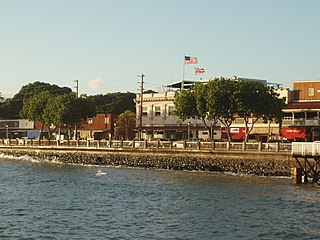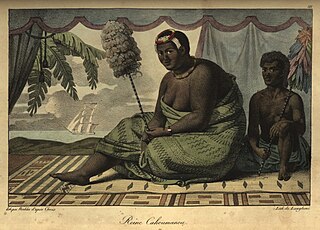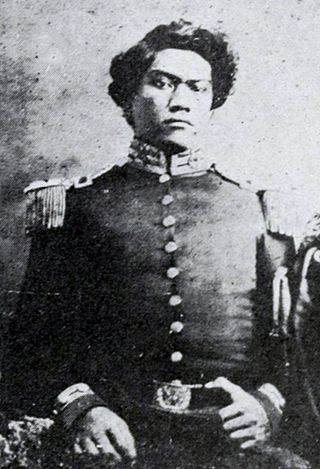Related Research Articles

Lahaina is a census-designated place (CDP) in Maui County, Hawaii, United States. On the northwest coast of the island of Maui, it encompasses Lahaina town and the Kaanapali and Kapalua beach resorts. As of the 2020 census, Lahaina had a resident population of 12,702. The CDP spans the coast along Hawaii Route 30 from a tunnel at the south end, through Olowalu, and to the CDPs of Kaanapali and Napili-Honokowai to the north.
The history of Hawaii describes the era of human settlements in the Hawaiian Islands. The islands were first settled by Polynesians sometime between 1000 and 1200 AD forming the modern population of Native Hawaiians. Hawaiian civilization was isolated from the rest of the world for at least 500 years.

Kaʻahumanu was queen consort and acted as regent of the Kingdom of Hawaiʻi as Kuhina Nui. She was the favorite wife of King Kamehameha I and also the most politically powerful, and continued to wield considerable power as co-ruler in the kingdom during reigns of his first two successors.

Kaumualiʻi was the last independent aliʻi nui of Kauaʻi and Niʻihau before becoming a vassal of Kamehameha I within the unified Kingdom of Hawaiʻi in 1810. He was the 23rd high chief of Kauaʻi and reigned during 1794–1810.

Kamehameha III was the third king of the Kingdom of Hawaii from 1825 to 1854. His full Hawaiian name is Keaweaweʻula Kīwalaʻō Kauikeaouli Kaleiopapa and then lengthened to Keaweaweʻula Kīwalaʻō Kauikeaouli Kaleiopapa Kalani Waiakua Kalanikau Iokikilo Kīwalaʻō i ke kapu Kamehameha when he ascended the throne.

The House of Kamehameha(Hale O Kamehameha), or the Kamehameha dynasty, was the reigning royal family of the Kingdom of Hawaiʻi, beginning with its founding by Kamehameha I in 1795 and ending with the death of Kamehameha V in 1872 and Lunalilo in 1874. The kingdom continued for another 21 years, until its overthrow in 1893 with the fall of the House of Kalakaua.

John Adams Kiʻiapalaoku Kuakini (1789–1844) was an important adviser to Kamehameha I in the early stages of the Kingdom of Hawaii. He was responsible for contributing to the infrastructure among other changes in the Kona District during this era.
The Aliʻi nui of Maui was the supreme ruler of the islands of Maui, one of the four main Hawaiian Islands as well as the smaller island of Lanai. The title is the same as that of the Aliʻi nui of the other islands. The title or phrase Mōʻī is sometimes used for the title of the monarchs of Maui; however, it is not an ancient word in the Hawaiian language and has origins in the mid 19th century. The only monarchs to officially hold the title of Mōʻī are Kalākaua and his sister Liliuokalani.
The House of Laʻanui is a family of heirs to the throne of the Kingdom of Hawaiʻi collateral to the House of Kamehameha. Both houses are branches of the House of Keōua Nui.
Kumalae was a Hawaiian High Chief, Aliʻi Nui (ruler) of Hilo. He is also known as Kumalae-nui-a-ʻUmi.
Lono-a-Piʻilani was Aliʻi of Maui. He was a chief of that Hawaiian island and was named after god Lono.
Kawaokaohele was a High Chief who ruled the island of Maui in ancient Hawaii.
Zorobabela Kaʻauwai was an early politician and judge in the Kingdom of Hawaii. Beginning as an assistant to the Hoapili, Governor of Maui, he served many political posts including Assistant Judge of the first Supreme Court of Hawaii, an original member of the Board of Commissioners to Quiet Land Titles, a multiple-term representative in the Hawaiian legislature and circuit judge for Maui. An early convert to Christianity and devout adherent of the Protestant faith, his first name is a Hawaiian form of the Biblical name Zerubbabel.
Kiha-a-Piilani was an Aliʻi nui of Maui. He was born ca. 1510.
Piʻikea was a High Chiefess. She was a daughter of Piʻilani and Chiefess La’ieloheloheikawai and sister of Lono-a-Piʻilani and Kiha-a-Piʻilani. Piʻilani built a great temple; according to the myth, Piʻilani was a son of Kū.
Kauhiakama (Kauhi-a-Kama) was a king of the island of Maui in ancient Hawaii.
Keleanohoanaʻapiʻapi, short name Kelea, was an ancient Hawaiian noblewoman who is mentioned in ancient legends, and her genealogy is given in chants. She was a Princess of Maui, one of the Hawaiian Islands. She was a High Chiefess, but not of the highest known rank.
David Kahalekula Kaʻauwai was a lawyer and politician of the Kingdom of Hawaii. He served two terms as a member of the House of Representatives of the Legislature of the Kingdom from 1854 to 1855. His father and younger brother were also legislators while his niece became a Princess of Hawaii.

William Hoapili Kaʻauwai was a Hawaiian high chief and politician, and religious deacon of the Kingdom of Hawaii. He served two terms as a member of the House of Representatives of the Legislature of the Kingdom in 1862 and 1870. He became the only Native Hawaiian to be ordained a priest of the Anglican Church of Hawaii and traveled with its founder Queen Emma to Europe between 1865 and 1866, circumnavigating the globe upon his return eastward via New Zealand.

Kalamakua — also known as Kalamakua-a-Kaipuholua — was an ancient Hawaiian nobleman, the High Chief of Halawa, a place on the island of Oahu.
References
- ↑ LEGEND OF KIHAPI‘ILANI
- ↑ David Malo, Hawaiian Antiquities, Honolulu: Bishop Museum Press, 1951
- ↑ "Kamalālāwalu (Kama-lālā-walu) (Mo'i, Ruler of Maui)". Archived from the original on 2014-05-03. Retrieved 2015-07-16.
- ↑ Kamakau, Samuel (1992). Ruling Chiefs of Hawaii. Honolulu: Kamehameha Schools Press. ISBN 0-87336-014-1.
- ↑ "Little Tales All About Hawaii". Archived from the original on 2023-01-12. Retrieved 2023-08-20.
{{cite web}}: CS1 maint: bot: original URL status unknown (link) - ↑ Peleioholani, Solomon Lehuanui Kalaniomaiheuila, The Complete Ancestry of John Liwai Kalniopuuikapali-o-Molilele-ma-wai-o-Ahukini-Kau-Hawaii Ena
- ↑ Glenda Bendure; Ned Friary (2008). Lonely Planet Maui . Lonely Planet. pp. 242–. ISBN 978-1-74104-714-1.
- ↑ "Piʻilani's family". Archived from the original on 2015-03-04. Retrieved 2015-07-16.
- ↑ The Stories of the Genealogies of Maui